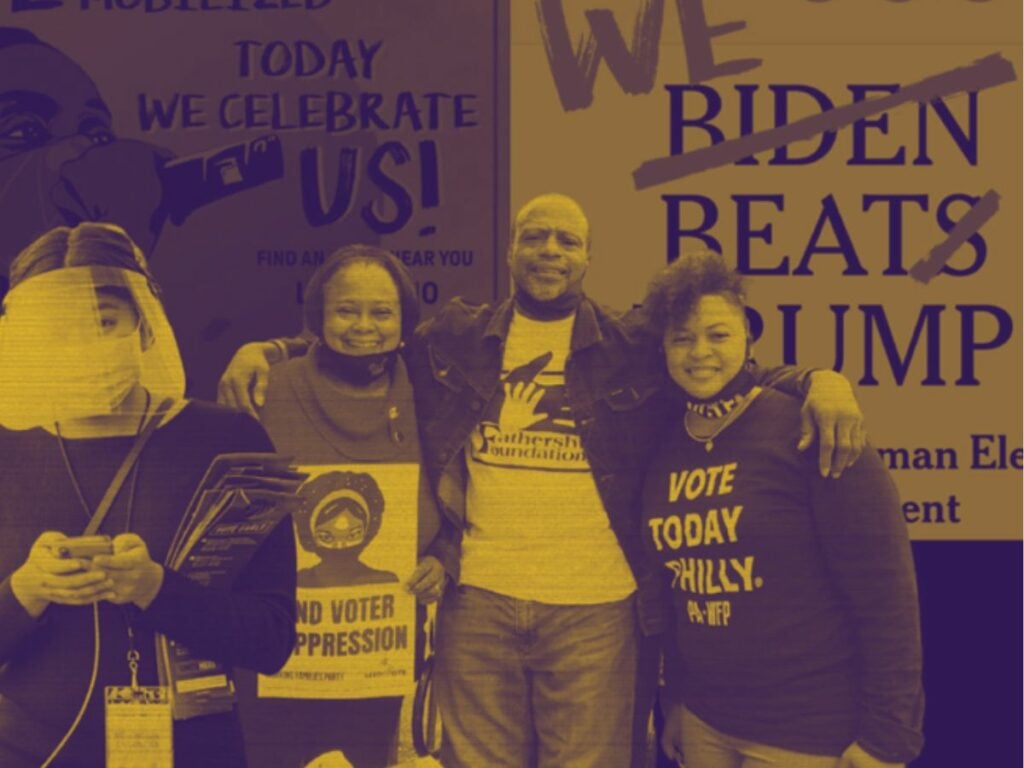In 2019 a group of left organizers and activists in the Bay Area started talking about the roles they could play to deny Trump a second term in 2020. As residents of a solidly blue state, they saw a need to connect Left volunteers from blue states with state and local groups organizing in working-class communities and communities of color in key battleground states.
The model they developed, called Seed the Vote (STV), worked in partnership with grassroots groups to expand the electoral ecosystem. Seed the Vote volunteers learned about the integrated voter engagement programs that local, state, and national organizing groups were engaged in, and how their electoral work is part of longer-term strategies to build progressive power in their states.
Convergence’s Sandra Hinson caught up with Rose Mendelsohn, STV Organizing Director and one of the co-authors of the chapter they contributed to Power Concedes Nothing. She asked Rose why it was important for STV to be part of the book and what lessons from 2020 they are bringing into the 2022 midterms and beyond.
“Seed the Vote was an experiment,” Mendelsohn said. “We saw a need and we tried to fill it. We also assumed it would be a one-time project, responding to the urgency of 2020. We were committed to both evaluating and documenting the work. Along with our report on 2020, writing the chapter gave us an opportunity to step back, after a chaotic year, and offer both a narrative and some analysis about Seed the Vote. Doing so has helped us reevaluate our plans and decide to keep building for the 2022 midterms and for the long-term.
“Many of our partners were also writing about their 2020 electoral work for Power Concedes Nothing. We could not pass up an opportunity to be in conversation with our partners from Arizona, Florida, Georgia, and Pennsylvania, as well as UNITE-HERE, the Working Families Party and People’s Action.
Understanding the moment
“There were a lot of uncertainties and worries going into the summer of 2020. We had our model pretty well-developed––some relationships were in place, as were the mechanisms. But there was no guarantee that our model would be met with the needed momentum. Multiple crises began to heat up. The pandemic disrupted groups’ organizing plans. The uprisings for Black lives in the wake of George Floyd’s murder were very powerful and essential. We weren’t sure how either of these developments would impact the elections and our role.
“We were clear from the start that our model needed to be nimble, so that we could shift in response to changing conditions. Because we had built the relationships and set up the mechanisms early, we were able to meet the moment, and to capture the momentum as it started to build.
“For the 2022 midterms, we again face uncertainties, doubts, and disillusionment. We need to fully understand the moment we are in. This is a very different election season. Building momentum may look different this time around. We are engaging with our volunteers to understand how they are thinking in this moment, and how they see this work as part of a longer-term effort, for 2024 and beyond.
“We remind ourselves that fighting the Right is the challenge of our generation; it’s something we’ll need to do for the long haul. We are communicating with our partners about their long-term plans, as well as the immediate concerns they have for the midterms. Our strategy for getting people out includes different tactics based on the political realities in the communities.
Lessons for the midterms
“While we have a federal focus––congressional races––our partners are making sure state and local races are linked up in ways that are mutually reinforcing. Local elections may be the key to turnout in some communities. In others, it will be state races. In Wisconsin and Pennsylvania, our partners are connecting gubernatorial races with senate races.
“Our partner organizations are also working to identify places where the state legislature, governor, Secretary of State, and courts are lining up to implement more voter restrictions. They are elevating the importance of electoral strategies that would stop them or, barring that, prevent the worst things from happening. In North Carolina, groups are making sure the races for the state legislature and the state supreme court are closely linked. The outcomes of these races will have implications for voting rights.
“Another lesson we learned in 2020 is that we should invest more in political education with our volunteers. This includes engagement with them around the longer-term political strategy as well as getting them well-grounded in the conditions that exist in the states. We want volunteers to know about and learn from our partners’ work on building long-term agendas, on navigating the differences between electoral mobilizations and deep base-building, on building solidarities across race, class, and geography.
“On the level of mechanics, we are building upon the seed pods and building new branches (yes, we are fully invested in the metaphor). The specific things we are building upon for the midterms include:
- The seed pods (small groups of people who are connected to each other): In 2020 we started out with centralized calling systems, then made it more distributed. This helped make the phone-banking process more relational, as volunteers shared skills and provided each other with mutual support and accountability. We want the seed pods to be even more relational this time around, with more volunteers bringing their family and friends into the work with them.
- The branches (where organized networks can plug into STV together): We are adding a geographic element to branches this time around, by building out branches in the Northeast, Midwest in the Pacific Northwest. This helps us reach more potential volunteers who can go to nearby red states. We are creating larger and more geographically diverse groups of participants.
“These new branches allow us to expand our geographic range, and to add new states: in addition to the work in Arizona, Georgia, and Pennsylvania, we will likely be working in Nevada, North Carolina, and Wisconsin.
“By the way, there is still time to make a big impact in the Wisconsin Senate race.
The primary is August 9. Consider signing up to phonebank or door-knock with our network of volunteers.”
From Power Concedes Nothing, “Fight the Right and Build the Left: Seed the Vote’s Work in 2020,” by Jill Shenker, Rose Mendelsohn, and Jason Negrón-Gonzales:
We built Seed the Vote with the idea that interstate support was necessary for victory in the 2020 election. We went through ups and downs with the pandemic, but held on to the core thread that progressive and left activists needed to support the fight in the battleground states. When Trump lost in some of those key battleground states, and when the Senate races were won in Georgia, the work was anchored by groups that had been present doing work on the ground over the last decade or more, but outside supporters made important contributions.
This type of active solidarity may be less common in community organizing, but it’s fairly common in the union movement. If 15 workers from a union local are unfairly fired and they decide to hold a worksite action, dozens if not hundreds of workers from other unions will join them. The workers unite to show up together where the fight is happening. In 2020, we wanted to approach our work in the same way. We know that voting and the electoral system in the United States is unfair. The Electoral College and Senate give undue weight to areas of the country that are older, more rural, and more white, and the Republican Party is doing everything it can, everywhere it has power, to disenfranchise voters of color.
We believe that our experience and the lessons we learned along the way are important to the battles ahead. The far right isn’t backing down, and neither should we. The electoral arena is a key front in the fight against the far right, and we have to show up and continue engaging in it. We must continue to experiment with new models of organizing and new infrastructure that makes the most of the strengths we have in our movements across the country and builds power for the long haul.
We must build infrastructure that is nimble and reactive, and we must constantly reassess our conditions and change our course of action as needed. We must continue to prioritize building long-term relationships rooted in trust and respecting each other’s areas of expertise. We must lean on our networks and make bold asks of our comrades. We must stick to the door-to-door and in-person tactics that are at the root of our people power. If we do this, and if we can redirect our strengths and resources to the fights that need them the most and ultimately impact all of us, we will put ourselves in the best position to defeat the far right and move closer to the thriving multiracial democracy that is possible in this country.
Featured image courtesy of Seed The Vote
Did you enjoy this article?
We're in the middle of our annual fund drive, and this year we're building our own internal infrastructure for subscriptions, meaning more of every dollar pledged goes to fulfilling our mission. Subscribe today to support our work and be a part of Convergence's next evolution.

